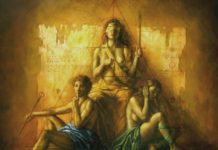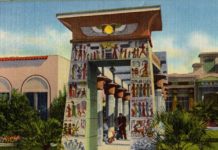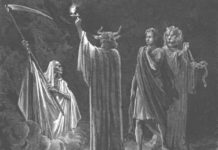This post provides what I call the ‘Pillars of the Rosicrucian Tradition,’ which represent the hallmarks of our mystical tradition, offering us signpost qualities that we may use to DEFINE the Rosicrucian current.
One important thing to mention here is that these pillars are not set in stone, and this is an ongoing-evolving concept that shall continue to be expanded upon as more information is rolled out on this blog.
But firstly, why try to define the Rosicrucian tradition?
I believe several Orders today claiming to be ‘Rosicrucian’ are a far cry of embodying the true beauty that is this tradition. Furthermore some Orders seem to have strayed on certain elements and this ongoing series of post may help Rosicrucian seekers realign to our enriching heritage.
In addition these Pillars serve to allow for a proper review of all the Rosicrucian Orders to be carried out. They shall serve as measuring sticks by which those Orders may be judged, ranked and awarded reviews and ratings, thus demonstrating their qualities and unique benefits for potential students.
This is why before reading my Reviews of the Rosicrucian Orders I recommend viewers take the time to go through these Pillars and get to know more about the method behind the reviews, how they were done and what kind of measuring sticks were put into place before the reviews were finalized.
Please note; these Pillars were carefully selected as the hallmarks of the Rosicrucian tradition based upon historical research coupled with intuitive promptings from my own mystical work delving into the Rosicrucian Link of Initiation I have been given. Thus, next to these intuitive insights a strong observation of the founding documents was also considered during the formulation of the Pillars in order to prove and support their formulation. Six documents have been selected for consideration.
- The Reformation of the Whole Wide World by Order of Apollo – 1614
- The Fama Fraternitatis – 1614
- The Confession of the Rosicrucians – 1615
- The Chemical Wedding of Christian Rosenkreuz – 1616
- The Mirror of Wisdom of the Rosy Cross – 1618
- Pegasus of the Firmament Pansophy of the R.C – 1618 Joseph Stellatus
All five of these documents set out very important principles, doctrines, elements and forms of mysticism that may be observed as comprising the original Rosicrucian tradition as according to those who conceived it and set this mystical tradition into motion.
In drawing from these original ideologies we shall also start see just how aligned the various Orders are to the Original Tradition.
Pillar One: Christianity
Any Order calling itself Rosicrucian needs to make reference to the Christ symbol. Period.
Some Orders will be seen as quoting the teachings of Christ to varying degrees. At a minimum I have set out the necessity of presenting Jesus as a central symbol of regeneration.
Failing to represent these symbols and teachings will disqualify any Order entirely. This is why I set this one pillar in stone: No Christ = No Rosicrucian Order. What kind of Christ figure that Order represents is completely up to them, be it as son of god, as inner master, as a solar Christ, or as a universal resurrection deity dating back to the tradition of Osiris. It doesn’t matter HOW that Christ is conveyed. What matters is that Christ is present in the Rosicrucian teachings.
As we have also seen in my post about the Hermetic elements of the Order there are also some conflicting symbols which certainly are NOT Christian. Apollo and Venus appear to be strongly connected to the original Rosicrucian manifesto documents. Such symbols certainly aren’t Christian and thus what we are looking for in particular when reviewing the Orders is a form of Christianity that is a flexible medium, adaptable to the Hermetic symbols and certainly not dogmatic.
Additional points will be awarded for conveying a syncretic form of Christianity as portrayed in the original Rosicrucian documents. Dogmatic forms of Christianity that utilize the Christ symbol to the exclusion of other symbols really goes against the grain of the original tradition and will be demerited.
This also goes for Orders that employ Gnosticism for their particular brand of Rosicrucian Christianity. As we have seen in my post ‘Are Rosicrucians Gnostics?’ it was shown that Gnosticism runs strongly against Rosicrucian cosmology. Just to recap on those points: Gnostics were haters of Nature, and saw nature as a prison and despised material existence, calling it a trap and diversion. Following the Hermetic train of thought the Rosicrucians view Nature as ‘God revealing’ and see Nature as a divine teacher, so that for Rosicrucians there are two books; the Gospel and the Book of Nature.
Gnosticism also runs in reverse of the Rosicrucian order of universal Reintegration. Gnosticism seems a bit anti-feminine here because in the Gnostic universe it is the female Sophia, who has fallen. As a fallen being she wanders until she is glorified in her wedding with Christ in heaven. Contrary to this at the time of the Rosicrucian manifestos many Germans, including Andreas who wrote the manifestos, believed in the existence of a redeeming female power. Sophia would redeem the fallen Adam they said, which is why Venus appears in a beautiful vision in the Wedding manifesto. The idea of a female redeemer in Wisdom in the form of Sophia was common amongst German Theosophers and this divine female, this goddess who saves and rebirths us, is opposite to the Gnostic failed and fallen Sophia.
This is why Orders claiming to be Rosicrucian yet using Gnostic doctrines will lose points, badly, because they have shown themselves to be too lazy to get behind the underlying ideologies. Just because ‘this has Sophia and Christ, and THAT has Sophia and Christ’ does not mean they work well together.
Christ Symbol: Possible Ten Points.
Syncretic Christianity: Plus Ten Points.
Gnostic Christianity: Minus Ten Points.
Pillar Two: Trinosophia – Cabala, Alchemy, Magic
The second factor that determines how true an Order is to our origins is found in the presence of an Orders’ actual teachings. A Rosicrucian Order must have Cabala, Alchemy and Magic in order to call itself ‘Rosicrucian.’ Now before I wipe out every Order in existence out there just because they do not teach laboratory alchemy let me here state that as in my above approach to viewing Christianity each of these three practices are also quite open to interpretation as well, depending on views.
So long as alchemical symbols are present to some extent, and so long as some form of Cabala is being taught, and so long as there is a true magical practice then it IS ROSICRUCIAN.
As I have explained in my post, the magic of the Rosicrucian Order is not a materialistic form of art, but rather is a Divine Magic, which is quite clear considering the materials and influences that led up to the formulation of the Rosicrucian documents. In particular Khunrath describes the same three words in his works as well as showing a Rose Cross and a seven sided city similar to that city of Andreas.
These three disciplines: Cabala, Alchemy and Magic combine to create the term Trinosophia, which means ‘The Three Arts of Wisdom’ and failure to represent them to any degree will result in harsh penalties in my reviews of the Rosicrucian Orders. Though Trinosophia is a later term applied to these arts by Cagliostro I will apply it here for the sake of simplicity as did Manly P. Hall. These three arts are explicitly mentioned in the manifestos and provide the blueprint for true Rosicrucian practice.
Each of these arts also carries a specific goal.
- Cabala: Reconciliation
- Magic: Reintegration
- Alchemy: Regeneration
Any single one of these practices demands a life time of study, achieving all three demands exceptional dedication, resources and divine guidance. Who would dare claim such mastery?
It should be noted here that the mystical exercises related to ‘mind power’ as drawn from the new thought movement does not comprise a true art of magic. I believe it is far too watered down and simplistic to warrant a true magical tradition. Mental-alchemy practices are also too wishy-washy at best. Often described as ‘inner alchemy’ these forms of inner change and self-development are too far removed from actual alchemical practice as it was intended by our Rosicrucian-inspirers. That being said there are some inner forms of alchemy that follow the true Royal Art processes which work on reconciling internal solar and lunar forces and have belonged to Rosicrucian history for quite some time. The Arcana Arcanorum for example teaches an internal alchemy mirroring the hermetic practice.
Cabala: Ten Points.
Alchemy: Ten Points.
Magic: Ten Points for Divine Magic.
Pillar Three: Pansophy – Utopianism & Unified Universal Schemata
Pansophy is a relatively new word for many because it has recently made a comeback on the Rosicrucian scene through the efforts of my friends and this blog. My first post on Pansophy showed that the Rosicrucian tradition is securely tied to the notion of Pansophy as described in the final Rosicrucian manifesto. Just in case you missed it Pansophy embraces quite a few ideas.
The first idea it teaches is the idea of Reformation which is a continuation of the other Rosicrucian manifestos. However where Pansophy differs is that here Reformation ceases to be just an idea, seeing that through Pansophy the vision of reformation now takes shape and form. My second post on Pansophy showed that the Rosicrucians intended to reform the world through education, in that by teaching everyone everything the resulting adults would be ready to receive higher ideas of Godhead.
The direction of this highly learned humanity has a guiding light in the distance however. Pansophy also entails a vision for a utopian society in which the very architecture of these divinely inspired cities would serve to remind us of divine form and principles. The envisioned cities are also educational vehicles that help residents always learn just by viewing its walls, as well as having at its heart a sacred temple. Like the Round Table of King Arthur, there are no quarters of class but instead such a city follows a sacred geometric pattern whether seven sided, square or circular; they are Cities of the Sun.
It is in the realm of Pansophy that many Rosicrucian Orders have lost their roots. Few Orders today describe a true Reformation and cultural regeneration of humanity. Next to none of them hold a utopian vision for humanity. So do not be surprised if Orders are scored down on this factor.
The third aspect of Pansophy is the universal schemata. I have not done a post describing this subject at all, not only because the task is daunting but also because it takes years to learn and comprehend. Several systems such as the Cabala have a universal framework for everything. That is not what I am talking about here, but it is a PART of it. Not only does Pansophy have such a framework, it also has a mythic cycle for the way to creation and the way of return. Again schools of Cabala seem to contain this. But this is not what I am talking about here either. Further to the framework and further to the mythic cycle there are also certain signposts of the mythic cycle which categorize some myths as Pansophic and others as not so this is where the review will weed out a few failures.
In addition to all this the Order itself should also mirror not only the universal framework of the heavens and earth but also the mythic cycle. The forth aspect of this is that the Pansophic schemata also entails a mystical practice which mirrors the schemata of the actual Order itself. The Order has a three tier system and from this you get Reconciliation, Reintegration and Regeneration, which in turn reflects a three tiered universe. This way the path to regeneration is a mirror of everything and the Order itself is a teaching vehicle revealing symbolic clues towards the hidden Rosicrucian art.
In this respect we also see the connection between the solar city of Andreas and his solar brotherhood of Rosicrucians. The cloister monks are a generator manifestation towards the utopian civilization.
Resolving the issue of Pansophy I am in the middle of writing a book which explains the big picture.
For now people will have my blog as reference to the Utopian aspect and the Reformation aspect of Pansophy and will have to hold tight to get hold of the final and more important parts.
Reformation Quest: Ten Points.
Utopian Vision: Ten Points.
Universal Schemata: Ten Points
The Twenty Points Wild Card
So far the above Three Pillars potentially award up to 80 points out of 100. That leaves 20.
Now, some people are going to balk as their beloved Order is scrutinized against this system. But you have to bear in mind that this initial review is done from a traditionalist baseline. I am comparing these modern Orders against what was earlier laid out as the blueprint for a Rosicrucian Order.
All the reference documents may be reviewed and examined. It’s now up to us, as members and seekers, to be honest and lift our game where we fall short of embodying this beautiful heritage.
Where some Orders will do badly in these reviews I will state here: DON’T WORRY! Chillax.
A second series of reviews is coming where I review each order from a completely different approach; being done from the perspective of just being a person who wants to learn spirituality. Ok 🙂
Spirituality and realizations is what it’s all about after all. So why not also consider these Orders on those merits as well. After all some Orders might do very well traditionally, but at the same time that reviewed order might suck eggs as a vehicle for providing real spiritual guidance and community.
This is where the last twenty points will come in. The last twenty points is the wild card.
Any Order has the chance to redeem itself against the backlash of failing traditionally.
Up to 20 points can be awarded in recognition of other qualities. These final points can be awarded for any merits that appear to be an outstanding quality of that Order under question.
An example might be: ten points could be given for providing a serious approach to the Way of the Heart and another ten for another quality that is implied in the manifestos. In both cases the wild card points were awarded because the Order is highlighting another aspect of the tradition.
As you can imagine these final points might also indicate the performance factor of an Order in the coming second series of reviews. After the second series of reviews you end up with one set of values for their traditional score and another set of values for their spiritual guidance score.
Side by side these values are quite telling and we may stumble upon some stark contrast as well as happy compromises for students, depending on what you are after.
All in all I am willing to give each Order a fair go. I invite anyone to participate and comment in our Facebook Group Rosicrucian Tradition here. Feel free to share your views and take part in these reviews.
Many thanks for reading, time for my hazelnut coffee.
Samuel Robinson
Founder of Pansophers
Cover image credit and thanks to Jake Baddely











Dear Sam,
this is a really intriguing and well made introduction to the rosicrucian knowledge and your experience with itself such as with other related subject. I will enjoy reading it
I don’t buy the need for a utopian vision, or if a group holds one it should be a good and viable one.
The humanists of the 16th century saw education as a key to human development. It was not utopian but doable. It took a while, but universal education for all is still an accepted vision. Less useful are the utopian visions-based loosing on Plato where an educated elite rule a structured society. The French synarchy movement (which saw its chance during the Vichy government in France is an example.
Reformation is different from utopianism. The Rosicrucians had a good reason to want reformation but their “utopia” was simply freedom from the control of the Roman Catholic church. These goals were obtained through secularism and did not require any utopian visions
Ein wichtiges Kriterium fehlt: Die Kreuzrose muss unsichtbar sein. In dem Sinne, dass Rudolf Steiner die Antrophosophie des Rosenkreuzes auszeichnete. F.
One important criterion is missing: The cross rose must be invisible. In the sense that Rudolf Steiner distinguished the Antrophosophy of the Rose Cross. F.
Manca un criterio importante: la croce rosa deve essere invisibile. Nel senso che Rudolf Steiner distingue Antrophosophy dalla Rose Cross. F.
Il manque un critère important: La rose croix doit être invisible. Dans le sens ou Rudolf Steiner a distinguer l’Antrophosophie de la Rose Croix
קריטריון חשוב אחד חסר: ורד הצלב חייב להיות בלתי נראה. במובן זה שרודולף
שטיינר הבדיל בין אנטרופוסופיה לבין צלב הוורדים
Отсутствует один важный критерий: роза креста должна быть невидимой. В том смысле, что Рудольф Штайнер отличал Антрофософию от Розового Креста. F.